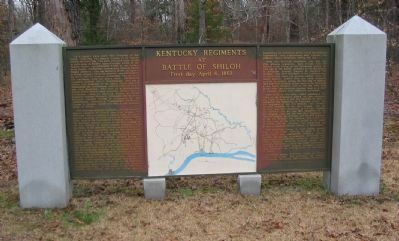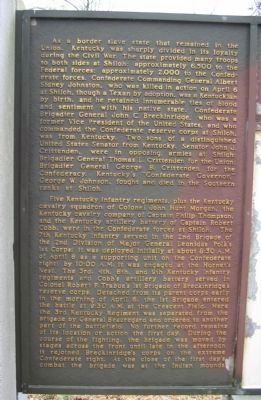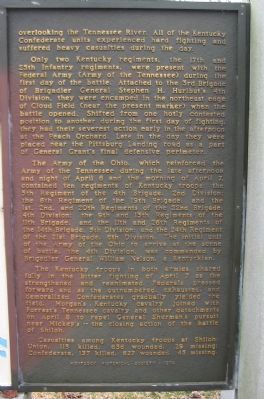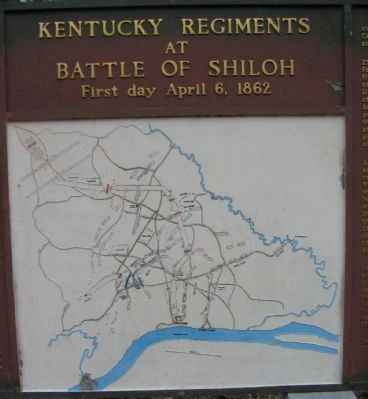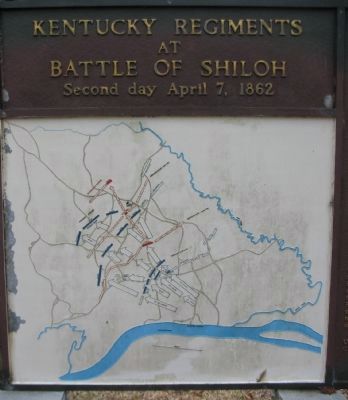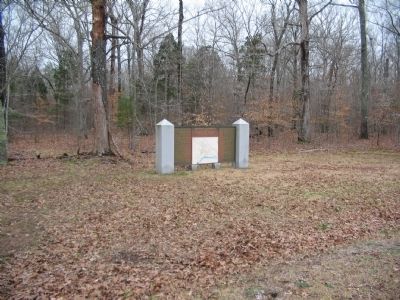Near Shiloh in Hardin County, Tennessee — The American South (East South Central)
Kentucky Regiments at Battle of Shiloh
As a border slave state that remained in the Union, Kentucky was sharply divided in its loyalty during the Civil War. The state provided many troops to both sides at Shiloh; approximately 6,500 to the Federal forces; approximately 2,000 to the Confederate forces. Confederate Commanding General Albert Sidney Johnston, who was killed in action on April 6 at Shiloh, though a Texan by adoption, was a Kentuckian by birth, and he retained innumerable ties of blood and sentiment with his native state. Confederate Brigadier General John C. Breckenridge, who was a former Vice President of the United States, and who commanded the Confederate reserve corps at Shiloh, was from Kentucky. Two sons of a distinguished United States Senator from Kentucky, Senator John J. Crittenden, were in opposing armies at Shiloh: Brigadier General Thomas L. Crittenden for the Union; Brigadier General George B. Crittenden for the Confederacy. Kentucky's "Confederate Governor," George W. Johnson, fought and died in the Southern ranks at Shiloh.
Five Kentucky infantry regiments, plus the Kentucky cavalry squadron of Colonel John Hunt Morgan, the Kentucky cavalry company of Captain Philip Thompson, and the Kentucky artillery battery of Captain Robert Cobb, were in the Confederate forces at Shiloh. The 7th Kentucky Infantry served in the 2nd Brigade of the 2nd Division of Major General Leonidas Polk's 1st Corps; it was deployed initially at about 8:30 A.M. of April 6 as a supporting unit on the Confederate right; by 10:00 A.M. it was engaged at the Hornet's Nest. The 3rd, 4th, 6th, and 9th Kentucky Infantry regiments and Cobb's artillery served in Colonel Robert P. Trabue's 1st Brigade of Breckenridge's reserve corps. Detached from its parent corps early in the morning of April 6, the 1st Brigade entered the battle at 9:30 A.M. at the Crescent Field. Here the 3rd Kentucky Regiment was separated from the brigade by General Beauregard and ordered to another part of the battlefield. No further record remains of its location or action the first day. During the course of fighting, the brigade was moved by stages across the front until late in the afternoon it rejoined Breckenridge's corps on the extreme Confederate right. At the close of the first day's combat the brigade was at the Indian mounds overlooking the Tennessee River. All of the Kentucky Confederate units experienced hard fighting and suffered heavy casualties during the day.
Only two Kentucky regiments, the 17th and 25th Infantry regiments, were present with the Federal Army (Army of the Tennessee) during the first day of the battle. Attached to the 3rd Brigade of Brigadier General Stephen H. Hurlbut's 4th Division, they were encamped in the northeast edge of Cloud Field (near the present marker) when the battle opened. Shifted from one hotly contested position to another during the first day of fighting, they had their severest action early in the afternoon at the Peach Orchard. Late in the day they were placed near the Pittsburg Landing road as a part of General Grant's final defensive perimeter.
The Army of the Ohio, which reinforced the Army of the Tennessee during the late afternoon and night of April 6 and the morning of April 7, contained ten regiments of Kentucky troops: the 5th Regiment of the 4th Brigade, 2nd Division; the 6th Regiment of the 19th Brigade, and the 1st, 2nd, and 20th Regiments of the 22nd Brigade, 4th Division; the 9th and 13th Regiments of the 11th Brigade, and the 11th and 26th Regiments of the 14th Brigade, 5th Division; and the 24th Regiment of the 21st Brigade, 6th Division. The initial unit of the Army of the Ohio to arrive at the scene of battle, the 4th Division, was commanded by Brigadier General William Nelson, a Kentuckian.
The Kentucky troops in both armies shared fully in the bitter fighting of April 7 as the strengthened and reanimated Federals pressed forward as the outnumbered, exhausted, and demoralized Confederates gradually yielded the field. Morgan's Kentucky cavalry joined with Forrest's Tennessee cavalry and other detachments on April 8 to repel General Sherman's pursuit near Mickey's - the closing action of the battle of Shiloh.
Casualties among Kentucky troops at Shiloh: Union 115 killed, 636 wounded, 29 missing; Confederate 137 killed, 627 wounded, 45 missing.
Topics and series. This historical marker is listed in this topic list: War, US Civil. In addition, it is included in the Former U.S. Presidents: #18 Ulysses S. Grant series list. A significant historical month for this entry is April 1862.
Location. 35° 8.475′ N, 88° 19.558′ W. Marker is near Shiloh, Tennessee, in Hardin County. Marker is on RIverside Drive (Brown's Ferry Road), on the left when traveling east. Located in the northeast portion of Shiloh National Military Park, just east of Cloud Field. Touch for map. Marker is in this post office area: Shiloh TN 38376, United States of America. Touch for directions.
Other nearby markers. At least 8 other markers are within walking distance of this marker. Chickasaw Homeland (within shouting distance of this marker); Camp of 17th Kentucky Infantry (about 300 feet away, measured in a direct line); Shiloh Indian Mounds (about 400 feet away); Sifting the Evidence (about 500 feet away); a different marker also named Shiloh Indian Mounds (about 500 feet away); Mississippian Indians (about 500 feet away); Vibrant Community (approx. 0.3 miles away); Richardson's Battery (approx. 0.3 miles away). Touch for a list and map of all markers in Shiloh.
Additional commentary.
1. Points of Contention with the Text
There are several points of contention with the text on this memorial. First Brig. Gen. George Crittenden had been relieved of command seven days before the battle, and was likely not on the field. Second, Trabue's Brigade consisted of the 3rd, 4th, 5th, and 6th Kentucky (instead of the 9th). And that brigade was not engaged at Crescent Field until around noon (instead of 9:30 a.m. as stated in the text). Finally the presence of Morgan's cavalry in the action of April 8, 1862 can be disputed.
— Submitted August 29, 2009, by Craig Swain of Leesburg, Virginia.
Credits. This page was last revised on June 16, 2016. It was originally submitted on August 29, 2009, by Craig Swain of Leesburg, Virginia. This page has been viewed 3,247 times since then and 131 times this year. Photos: 1, 2, 3, 4, 5, 6. submitted on August 29, 2009, by Craig Swain of Leesburg, Virginia.
